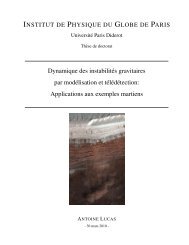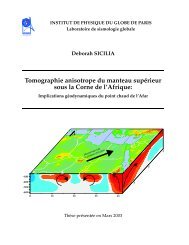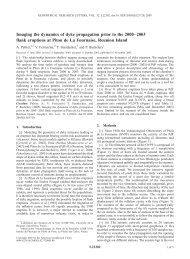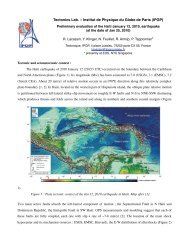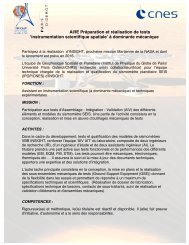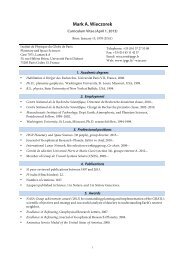Edifice growth, deformation and rift zone development in basaltic ...
Edifice growth, deformation and rift zone development in basaltic ...
Edifice growth, deformation and rift zone development in basaltic ...
Create successful ePaper yourself
Turn your PDF publications into a flip-book with our unique Google optimized e-Paper software.
L. Michon et al. / Journal of Volcanology <strong>and</strong> Geothermal Research 184 (2009) 14–30<br />
29<br />
<strong>zone</strong>. The direction of the eruptive fissures <strong>in</strong> the eastern flank suggests<br />
that the fault <strong>zone</strong> controls the magma <strong>in</strong>trusion <strong>in</strong> the eastern part of<br />
the cone. Numerical models show that the N55–65 fault <strong>zone</strong> may be<br />
punctually reactivated by stresses related to dyke <strong>in</strong>trusions along the<br />
<strong>rift</strong> <strong>zone</strong>s. They also <strong>in</strong>dicate that the <strong>development</strong> of the fault <strong>zone</strong><br />
does probably not result from <strong>in</strong>trusion-related stresses. Hence, we<br />
propose that the N55–65 fault <strong>zone</strong> is a tectonic structure <strong>in</strong>herited<br />
from the collapse of the Enclos Fouqué caldera, which is reactivated by<br />
the present-day dynamics of the magmatic system.<br />
Our numerical models <strong>and</strong> GPS data <strong>in</strong>dicate that the recurrent<br />
<strong>in</strong>trusions along the <strong>rift</strong> <strong>zone</strong>s <strong>in</strong>duce a heterogeneous <strong>deformation</strong> of<br />
the cone with (i) a significant <strong>in</strong>flation of the eastern part of the summit,<br />
(ii) the steepen<strong>in</strong>g of the southeast <strong>and</strong> east flanks, <strong>and</strong> (iii) very slight<br />
tilt<strong>in</strong>g of the western part (Fig. 9a). The superposition of the tilted <strong>zone</strong>s<br />
<strong>and</strong> the N55 <strong>and</strong> N150 very steep slope <strong>zone</strong>s strongly suggests that the<br />
slope value difference of about 5–10° between the east <strong>and</strong> southeast<br />
flanks, <strong>and</strong> the west <strong>and</strong> north flanks results from the endogenous<br />
<strong>growth</strong> associated with <strong>in</strong>tra-cone <strong>in</strong>trusions along the N25–30 <strong>and</strong><br />
N120 <strong>rift</strong> <strong>zone</strong>s (Fig. 9). Hence, if most of the present morphology of the<br />
central cone results from an exogenous <strong>growth</strong>, the specific morphology<br />
of the cone's eastern part is clearly due to endogenous processes.<br />
The absence of any elongation along the N25–30 <strong>rift</strong> <strong>zone</strong> despite the<br />
substantial concentration of the <strong>in</strong>trusions along this structure contrasts<br />
with the morphologies of Hawaiian volcanoes <strong>and</strong> Karthala. Annen et al.<br />
(2001) showed that the geometry of the volcanoes was sensitive to the<br />
dyke length/source depth ratio. Volcanoes with ratios lower than 1<br />
present an elongation perpendicular to the <strong>rift</strong> <strong>zone</strong>s, whereas the<br />
elongation is parallel to the <strong>rift</strong> <strong>zone</strong>s for ratios greater than 1. For ratios<br />
close to one, the edifice rema<strong>in</strong>s circular despite the presence of radial<br />
<strong>rift</strong> <strong>zone</strong>s. At Piton de la Fournaise, the mean dyke length along the<br />
northern <strong>and</strong> southern segments of the N25–30 <strong>rift</strong> <strong>zone</strong> <strong>and</strong> the source<br />
depth are of the same range (about 2000 m). Then, the <strong>development</strong> of<br />
short dykes along the N25–30 <strong>and</strong> N120 <strong>rift</strong> <strong>zone</strong>s may expla<strong>in</strong> the subcircular<br />
geometry of the central cone.<br />
The N25–30 <strong>and</strong> N120 <strong>rift</strong> <strong>zone</strong>s were determ<strong>in</strong>ed from the<br />
orientation <strong>and</strong> location of the dykes <strong>in</strong>truded s<strong>in</strong>ce 1981. Michon<br />
et al. (2007a) proposed that the N25–30 <strong>rift</strong> <strong>zone</strong>, on which the cone<br />
built up, results from recurrent magma <strong>in</strong>trusions along a large, 10 kmlong<br />
structure <strong>in</strong> the Enclos caldera floor. The orig<strong>in</strong> of the N120 <strong>rift</strong> <strong>zone</strong><br />
is less constra<strong>in</strong>ed. It could be related to the regional N120-trend<strong>in</strong>g<br />
volcanic <strong>zone</strong> between Piton des Neiges <strong>and</strong> Piton de la Fournaise, the<br />
<strong>development</strong> of which has been <strong>in</strong>terpreted as to be controlled by N120<br />
crustal faults (Fig. 1; Chevalier <strong>and</strong> Vat<strong>in</strong>-Perignon, 1982; Michel <strong>and</strong><br />
Zlotnicki, 1998; Michon et al., 2007a). However, the lack of any N120-<br />
trend<strong>in</strong>g <strong>in</strong>trusions <strong>in</strong> the Enclos caldera, west of the N25–30 <strong>rift</strong> <strong>zone</strong>,<br />
<strong>and</strong> the contrasted geometries between the narrow <strong>rift</strong> <strong>zone</strong> east of the<br />
cone <strong>and</strong> the wide volcanic <strong>zone</strong> between Piton de la Fournaise <strong>and</strong><br />
Piton des Neiges suggest a different orig<strong>in</strong> of both structures. Our<br />
numerical modell<strong>in</strong>g reveals that recurrent <strong>in</strong>trusions along the northern<br />
<strong>and</strong> southern segments of the N25–30 <strong>rift</strong> <strong>zone</strong> encourage <strong>in</strong>trusions<br />
<strong>in</strong> the N120 direction (Fig. 12a). Hence, we expla<strong>in</strong> both the existence of<br />
the N120 <strong>rift</strong> <strong>zone</strong> East of the N25–30 <strong>rift</strong> <strong>zone</strong> <strong>and</strong> the lack of N120<br />
trend<strong>in</strong>g dykes West of it, as a consequence of the general eastward dip<br />
of the N25–30 dykes (Fig. 12b). Such a geometry, which has been<br />
deduced from several sets of <strong>deformation</strong> data (Sigmundsson et al.,<br />
1999; Froger et al., 2004; Fukushima et al., 2005; Peltier et al., 2007,<br />
2008), <strong>in</strong>duces asymmetric <strong>deformation</strong>s associated with much larger<br />
stress changes East of the N25–30 <strong>rift</strong> <strong>zone</strong> than West. The small length<br />
of the N120 <strong>rift</strong> <strong>zone</strong> may orig<strong>in</strong>ate from a rapid decrease of the stress<br />
<strong>in</strong>crease due to the N25–30 <strong>in</strong>trusions away from the plumb<strong>in</strong>g system.<br />
This <strong>rift</strong> system, which has been determ<strong>in</strong>ed from the summit <strong>and</strong><br />
proximal <strong>in</strong>trusions is not fully connected with the NE <strong>and</strong> SE <strong>rift</strong> <strong>zone</strong>s<br />
outside the Enclos caldera. Indeed, recent geophysical data (Brenguier<br />
et al., 2007) suggest that the NE <strong>and</strong> SE <strong>rift</strong> <strong>zone</strong>s along which the distal<br />
eruptions occur are related to tectonic structures that are located below<br />
the magma chamber that feeds the summit <strong>and</strong> proximal eruptions.<br />
6. Conclusion<br />
Our work corresponds to the first analysis of the central cone of<br />
Piton de la Fournaise, which comb<strong>in</strong>es structural <strong>and</strong> GPS data, <strong>and</strong><br />
numerical modell<strong>in</strong>g. The ma<strong>in</strong> results can be summarised as follows:<br />
(1) Similarly to Nyiragongo (Demant et al., 1994), the central cone<br />
is formed by a pyroclastic core overlapped by few tens of metres<br />
of lava flows. The general steep geometry of the cone does<br />
consequently not result from endogenous processes but from<br />
an <strong>in</strong>itial phase dur<strong>in</strong>g which a pyroclastic cone formed.<br />
(2) The cone undergoes a contrasted co-<strong>in</strong>trusive <strong>deformation</strong><br />
dur<strong>in</strong>g summit <strong>and</strong> proximal eruptions along two N25–30 <strong>and</strong><br />
N120 <strong>rift</strong> <strong>zone</strong>s. Most of the co-<strong>in</strong>trusive displacements are<br />
concentrated <strong>in</strong> its eastern half where they <strong>in</strong>duce a progressive<br />
outward <strong>in</strong>flation <strong>and</strong> the tilt<strong>in</strong>g of the eastern <strong>and</strong> southeastern<br />
flanks. A dense network of flank fractures, which differs from<br />
the eruptive fissures <strong>and</strong> the concentric fractures l<strong>in</strong>ked to the<br />
summit collapses, accommodate the progressive endogenous<br />
<strong>growth</strong>.<br />
(3) The dynamics of the plumb<strong>in</strong>g system also reactivates a N55<br />
fault <strong>zone</strong>, which ma<strong>in</strong>ly controls magma <strong>in</strong>trusions <strong>in</strong> the<br />
eastern flank <strong>and</strong> decouples the <strong>deformation</strong> of the Enclos<br />
caldera floor dur<strong>in</strong>g the north-eastward distal eruptions.<br />
(4) The N25–30 <strong>rift</strong> <strong>zone</strong> is related to a large, 10–km-long fracture<br />
<strong>zone</strong>, whereas the short, narrow N120 <strong>rift</strong> <strong>zone</strong> results from a<br />
N120-trend<strong>in</strong>g stress accumulation west of the N25–30 <strong>rift</strong><br />
<strong>zone</strong>, which guides magma <strong>in</strong>trusions.<br />
Acknowledgments<br />
The authors thank Ruth Andrew for improv<strong>in</strong>g an <strong>in</strong>itial version of<br />
the manuscript. Two anonymous reviewers are k<strong>in</strong>dly thanked for<br />
their constructive reviews, which helped to significantly improve the<br />
manuscript. This is IPGP contribution 2437.<br />
References<br />
Annen, C., Lénat, J.-F., Provost, A., 2001. The long-term <strong>growth</strong> of volcanic edifices:<br />
numerical modell<strong>in</strong>g of the role of dyke <strong>in</strong>trusion <strong>and</strong> lava-flow emplacement.<br />
J. Volcanol. Geotherm. Res. 105, 263–289.<br />
Bachèlery, P., 1981. Le Piton de la Fournaise (Ile de la Réunion). Etude volcanologique,<br />
structurale et pétrologique. PhD thesis, Univ. Clermont-Ferr<strong>and</strong> II, 215 pp.<br />
Bachèlery, P., Chevallier, L., Gratier, J.P.,1983. Caractères structuraux des eruptions historiques<br />
du Piton de la Fournaise (Ile de la Réunion). C. R. Acad. Sci. Paris 296, 1345–1350.<br />
Bory de Sa<strong>in</strong>t-V<strong>in</strong>cent, J.B.G.M., 1804. Voyage dans les quatre pr<strong>in</strong>cipales îles des Mers<br />
d'Afrique, Paris, XIII, 3 vol. <strong>in</strong> 8.<br />
Brenguier, F., Shapiro, N.M., Campillo, M., Nercessian, A., Ferrazz<strong>in</strong>i, V., 2007. 3-D surface<br />
wave tomography of the Piton de la Fournaise volcano us<strong>in</strong>g seismic noise<br />
correlations. Geophys. Res. Lett. 34, L02305. doi:10.1029/2006GL028586.<br />
Briole, P., Bachèlery, P., Mc Guire, B., Moss, J., Ruegg, J.-C., Sabourault, Ph., 1998.<br />
Deformation at Piton de la Fournaise: evolution of the monitor<strong>in</strong>g techniques <strong>and</strong><br />
knowledge acquired <strong>in</strong> the last five years. In: Casal, R., Fytikas, M., Sigvaldasson, G.,<br />
Vougioukalakis, G. (Eds.), Volcanic risk – the European laboratory volcanoes,<br />
European commission, EUR 18161 EN, pp. 467–474.<br />
Carter, A., van Wyk de Vries, B., Kelfoun, K., Bachèlery, P., Briole, P., 2007. Pits, <strong>rift</strong>s <strong>and</strong><br />
slumps: the summit structure of Piton de la Fournaise. Bull. Volcanol. 69, 741–756.<br />
doi:10.1007/s00445-006-0103-4.<br />
Cayol, V., Cornet, F.H., 1997. 3D mixed boundary elements for elastostatic <strong>deformation</strong><br />
field analysis. Int. J. Rock Mech. M<strong>in</strong>. Sci. 34, 275–287.<br />
Cayol, V., Cornet, F.H., 1998. Three-dimensional model<strong>in</strong>g of the 1983–1984 eruption at<br />
Piton de la Fournaise volcano, Réunion Isl<strong>and</strong>. J. Geophys. Res. 103, 18,025–18,037.<br />
Chevalier, L., Vat<strong>in</strong>-Perignon, N., 1982. Volcano-structural evolution of Piton des Neiges,<br />
Reunion Isl<strong>and</strong>, Indian Ocean. Bull. Volcanol. 45, 285–298.<br />
Delorme, H., Bachèlery, P., Blum, P.A., Chem<strong>in</strong>ée, J.L., Delarue, J.F., Delmond, J.C., Hirn, A.,<br />
Lep<strong>in</strong>e, J.C., V<strong>in</strong>cent, P.M., Zlotnicki, J., 1989. March 1986 eruptive episodes at Piton<br />
de la Fournaise volcano (Reunion Isl<strong>and</strong>). J. Volcanol. Geotherm. Res. 36, 199–208.<br />
Demant, A., Lestrade, P., Lubala, R.L., Kampuzu, A.B., Durieux, J., 1994. Volcanological <strong>and</strong><br />
petrological evolution of Nyiragongo volcano, Virunga volcanic field, Zaire. Bull.<br />
Volcanol. 56, 47–61.<br />
Froger, J.-L., Fukushima, Y., Briole, P., Staudacher, Th., Souriot, Th., Villeneuve, N., 2004.<br />
The <strong>deformation</strong> field of the August 2003 eruption at Piton de la Fournaise, Reunion<br />
Isl<strong>and</strong>, mapped by ASAR <strong>in</strong>terferometry. Geophys. Res. Lett. 31, L14601.<br />
doi:10.1029/2004GL020479.



